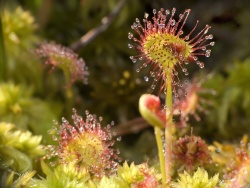Homeopathic Drosera
From Health Facts
Latest Edit: Hector 2014-03-18 (EDT)
| See Also | Homeopathic Monographs |
|---|
Dosera is predominantly a cough remedy and is well-known for its treatment of coughs, including whooping cough(pertussis).[1]
Source
- Plant: Drosera rotundifolia, also known as Sundew
- Short Form: Dros
Indications
The following are the main indications for Drosera.[2], [3]
Acute Conditions
- Cough with violent repetative and spasmodic coughing which is deep and barking. Episodes lasting 2-3 hours and follow each other rapidly. Retching at end of cough; vomits water, mucous, food. Violent fits of coughing with choking. Suffocative attacks. Cough from a tickle in the throat that feels like a crumb or feather. Hahnemann names this remedy the principle remedy for whooping cough; also for croup. Hold sides during cough. Nosebleeds, cold sweats, hoarseness. Worse when alone.
Other common conditions: Bronchitis, Croup, Pertussis, Tuberculosis
Characteristics
- Worse: lying down (as soon as the head hits the pillow), after midnight, talking
- Better: pressure, open air
- Psychological: becomes easily angered, may feel harassed or persecuted, suspicious, paranoid, under attack or attacking first
Prescribing Considerations
Homeopathic remedies are prescribed based on homeopathic principles and after a detailed case taking. The prescription recommendations below are provided only as a guide. It is always recommended to consult with a naturopathic doctor or homeopathic practitioner prior to taking any homeopathic remedies, especially if your health is compromised or if your symptoms due to resolve in a timely fashion. The general recommendations for Drosera include:[4]
- Antidote: Camphor
- Compare: Fluoroform (2% watery solution, 2-4 drops after paraoxysms considered specific for whooping cough), Ouabain from leaves of Carissa schimperi - arrow poison (Respiratory spasm- whooping cough is cut short in first stage and reduced in frequency of attacks and hastens convalescence), Chelidonium, Cuprum, Castanea, Argentum, Menyanthes
References
- ↑ Morrison Roger (1993) Desktop Guide, to Keynote and Confirmatory Symptoms Hahnmann Clinic Publishing.
- ↑ Hershoff Asa (2000) Homeopathic Remedies, A Quick and Easy Guide to Common Disorders and their Homeopathic Treatments Avery Publishing Group, New York.
- ↑ Ullman Robert, Reichenberg-Ullman Judyth (1997) Homeopathic Self-Care, the quick and easy guide for the whole family. Prima Publishing.
- ↑ Boericke W (1997) Pocket Manual of Homoeopathic Materia Medica and Repertory, a Chapter on Rare and Uncommon Remedies, B. Jain Publishers, India.
